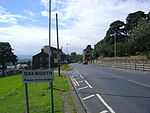Worth Valley (dale)

The Worth Valley is a geographic area in West Yorkshire, England, that extends eastwards from Crow Hill and Oxenhope Moor, providing drainage for the River Worth for nearly 10 miles (16 km) to the River Aire. It is a side valley to Airedale, with the River Worth being a major tributary of the River Aire. The Worth Valley was important for its contribution to the textiles industry of the West Riding of Yorkshire and was furnished with several reservoirs to allow mills to operate within the valley. Most of the reservoirs are still in use into the modern day. The valley has seen a shift in its industry from worsted, wool, and before that mining and quarrying, into a tourist location. The association with the Brontë family, and the Keighley and Worth Valley Railway, has drawn many visitors to the area, particularly from Japan. Connected with these attractions has been the film and TV industry which have recorded shots, programmes, and entire films in the area.
Excerpt from the Wikipedia article Worth Valley (dale) (License: CC BY-SA 3.0, Authors, Images).Worth Valley (dale)
Church Street, Bradford Haworth and Stanbury
Geographical coordinates (GPS) Address Nearby Places Show on map
Geographical coordinates (GPS)
| Latitude | Longitude |
|---|---|
| N 53.831 ° | E -1.956 ° |
Address
St Michael's and All Angels' Church
Church Street
BD22 8DU Bradford, Haworth and Stanbury
England, United Kingdom
Open on Google Maps











